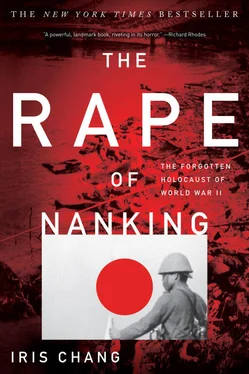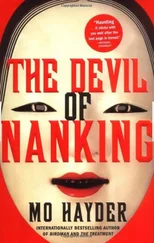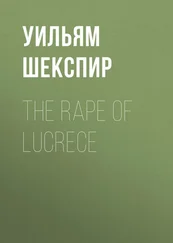122. The first two years for the Wilsons: Ibid.
122. After the Marco Polo Bridge incident in July: Robert Wilson, letter to family, August 18, 1937.
123. “He saw this as his duty”: Marjorie Wilson, telephone interview.
123. No doubt to dispel loneliness: Robert Wilson, letter to family, October 12, 1937, p. 15.
123. Most contained gruesome descriptions: Ibid., August 20, 1937, p. 9.
123. “a respectable museum”: Ibid., December 9, 1937, p. 35.
123. On September 25, in one of the worst air raids: Ibid., September 25 and 27, 1937; Minnie Vautrin, diary 1937–40, September 26, 1937, p. 33.
124. Heavy black curtains were drawn: Robert Wilson, letter to family, August 23, 1937.
124. There were approximately one hundred thousand wounded Chinese veterans: Commander Yangtze Patrol E. J. Marquart to Commander in Chief, U.S. Asiatic Fleet (letterhead marked “Yangtze Patrol, U.S.S. Luzon [Flagship]),” intelligence summary for week ending October 24, 1937, October 25, 1937, Office of the Chief of Naval Operations, Division of Naval Intelligence, general correspondence, 1929–42, folder A8–2/FS, box 194, entry 81, record group 38, National Archives; Minnie Vautrin, diary 1937–40, October 26 and November 8, 1937, pp. 55, 64 (she writes that some 100,000 soldiers have been injured or killed in the Shanghai area).
124. Soldiers who healed were returned: Ibid.
124. Chinese doctors and nurses: Minnie Vautrin, diary 1937–40, December 5, 1937, p. 96; Ernest and Clarissa Forster, letter to parents, December 7, 1937, Ernest and Clarissa Forster Collection.
124. Ultimately, however, he was unable to convince them: Robert O. Wilson (witness), testimony, Records of the Allied Operational /Occupation Headquarters, IMTFE transcript, entry 319, record group 331, pp. 2531–32, National Archives.
124. By the end of the first week of December: Mrs. E. H. Forster report, December 12, 1937, from newsletter in Ernest and Clarissa Forster Collection.
124. When Richard Brady: Robert Wilson, letter to family, December 2, 1937; A. T. Steele, “Tells Heroism of Yankees in Nanking,” Chicago Daily News, December 18, 1937.
125. “It is quite a sensation”: Robert Wilson, letter to family, December 7, 1937.
125. “naturally pretty shaky”: Ibid., December 14, 1937.
125. Wilson saw Japanese flags fluttering: Ibid.
125. They broke into the main hospital: Durdin, “Japanese Atrocities Marked Fall of Nanking”; Rabe, “Enemy Planes over Nanking”; an excerpt from a verbal presentation by Mr. Smith of Reuters about the events of Nanking on December 9–15, 1937, document no. 178, Hankow, January 1, 1938, in “Deutsche Botschaft China,” German diplomatic reports, National History Archives, Republic of China.
125. “swift kick”: Robert Wilson, letter to family, December 18, 1937.
125. He also watched soldiers burn a heap of musical instruments: Ibid., December 28, 1937.
126. “The crowning insult”: Ibid., December 19, 1937.
126. “December 15: The slaughter of civilians is appalling”: Ibid., December 15, 1937.
126. “December 18: Today marks the 6th day”: Ibid., December 18, 1937.
126. “December 19: All the food is being stolen”: Ibid., December 19, 1937.
126. “Christmas Eve: Now they tell us”: Ibid., December 24, 1937.
126. “The only consolation”: Ibid., December 30, 1937.
127. Frequently Wilson and the others saw the Japanese: Durdin, “Japanese Atrocities Marked Fall of Nanking.”
127. After the fall of Nanking, the big trenches: Robert Wilson, letter to family, December 24, 1937.
127. The Japanese soldiers he confronted: Robert Wilson, letter to family, December 21, 1937, p. 6; Marjorie Wilson, telephone interview with the author; John Magee to “Billy” (signed “John”), January 11, 1938, Ernest and Clarissa Forster Collection.
127. One of the worst scenes: Marjorie Wilson, telephone interview with the author.
127. He told his wife that he would never forget the woman: Ibid.
127. “This morning came another woman in a sad plight”: J. H. McCallum, diary entry for January 3, 1937, reprinted in American Missionary Eyewitnesses to the Nanking Massacre, 1937–1938, ed. Martha Lund Smalley (New Haven, Conn.: Yale Divinity School Library, 1997), p. 39.
128. Incredible account of survival: Robert Wilson, letter to family, January 1, 1938, p. 11.
128. Struggled with a fever of 102 degrees: Ibid., December 26, 1937, p. 7.
129. Survivors of the massacre remember: James Yin (coauthor of The Rape of Nanking ), telephone interview with the author. The information about McCallum comes from his research in China.
129. When the massacre and rapes gradually subsided: Margorie Wilson, telephone interview with the author.
130. Vautrin, the daughter of a blacksmith: Early biographical details about Vautrin come from Emma Lyon (Vautrin’s niece), telephone interview with the author, October 28, 1996.
130. In her diary, she never ceased to marvel: Most of the information for this section comes directly from Vautrin’s diary, 1937–40, Yale Divinity School Library. Although she used her own page-numbering system (on the top of the middle of each page), I have used the Yale Divinity School page numbers, which were stamped on the top right-hand corner of each diary page.
130. In the summer of 1937, while vacationing: Minnie Vautrin, diary 1937–40, July 2–18, 1937, p. 2.
130. Still, Vautrin refused to join the other Americans: Ibid., September 20, 1937, p. 27.
131. The embassy staff also gave her: Ibid., December 1 and 8, 1937, pp. 91, 100; Commanding Officer C. F. Jeffs to the Commander in Chief, U.S. Asiatic Fleet (letterhead marked the U.S.S. Oahu ), intelligence summary for the week ending February 13, 1938, February 14, 1938 (includes excerpt of missionary letter, which was not given to the press for fear of reprisals from the Japanese); George Fitch diary (name not given in report), Office of the Chief of Naval Operations, Division of Naval Intelligence, general correspondence, 1929–42, folder A8–21/FS#3, box 195, entry 81, record group 38, National Archives.
131. She labored to prepare the campus for female refugees: Minnie Vautrin, diary 1937–40, December 3, 6, and 7, 1937, pp. 94, 97, 98.
131. Vautrin also commissioned the sewing: Ibid., October 6, 1937, p. 41.
131. By the second week of December: Minnie Vautrin, “Sharing ‘the Abundant Life’ in a Refugee Camp,” April 28, 1938, box 103, record group 8, Jarvis Collection, Yale Divinity School Library.
131. Refugees were passing through the city: Letter to parents, probably from Forster, October 4, 1937, from Hsiakwan, Ernest and Clarissa Forster Collection.
131. Many of them, exhausted, bewildered, and hungry: 793.94/12060, report no. 9114, December 11, 1937, restricted report, General Records of the Department of State, National Archives.
131. “From 8:30 this morning”: Minnie Vautrin, diary 1937–40, December 15, 1937, p. 111.
131. Vautrin allowed the women and children: Ibid.
132. Vautrin’s heart sank: Ibid., December 16, 1937, pp. 112–13.
132. They certainly would have been killed: Ibid., December 16, 1937, p. 113.
132. A truck went by with eight to ten girls: Ibid., December 16, 1937, p. 114. In her diary, Vautrin records that the women screamed “Gin Ming,” but a more accurate translation of the Chinese expression for help is “Jiu Ming.”
Читать дальше











